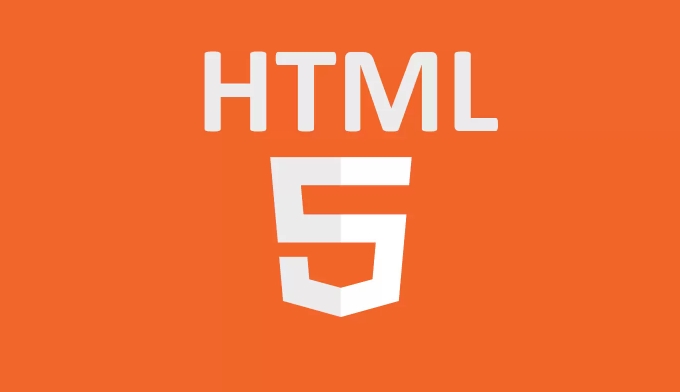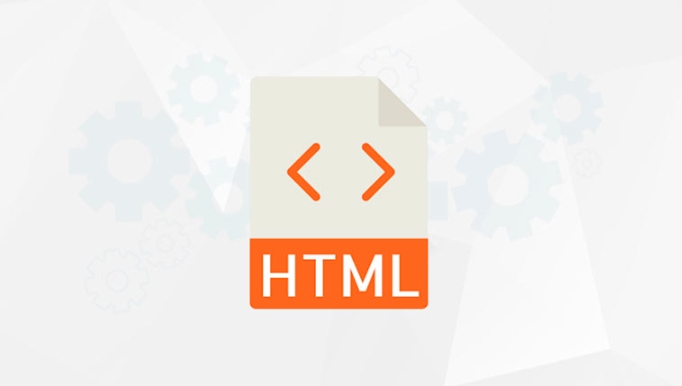To create an HTML single-page resume, the key is to have clear structure, concise style, responsive design and test release. 1. In terms of structure, use the header to place the name and contact information, section to display educational background, work experience, skills and other content in blocks, and footer can optionally place supplementary information; 2. Use appropriate font size (such as 16px), line height (1.5-1.6), color contrast and block spacing in the style to keep the page clean and easy to read; 3. Responsive design adjusts the font and layout through media queries to ensure good display on the mobile phone; 4. Finally, after local testing is correct, you can upload it to GitHub Pages or Netlify for release, and update the content regularly to keep the latest.

Want to use HTML to make a simple one-page resume? In fact, it is not difficult. As long as you master a few basic structures and style points, you can quickly build a clear and professional page. The key is to display your information concisely and clearly, while ensuring that it can be displayed normally on different devices.

Clear structure: How to build HTML skeleton?
The core of a resume page is structure. You can organize content with the most basic HTML tags, such as <section></section> , <h1></h1> , <p></p> , and <ul></ul> , etc.

The recommended basic structure is as follows:
-
<header></header>Put name and contact information -
<section></section>Put educational background, work experience, skills, etc. in pieces -
<footer></footer>Optional, put some additional information or link
This structure is clear and easy to identify with search engines, which is also helpful for post-optimization.

For example:
<header>
<h1>Zhang San</h1>
<p>Email: zhangsan@example.com | Phone: 123-456-7890</p>
</header>
<section>
<h2>Work experience</h2>
<p><strong>Front-end development engineer-ABC Company</strong></p>
<p>2022 to present</p>
<ul>
<li>Responsible for the front-end development of the website</li>
<li>Build components using React</li>
</ul>
</section>Simple style but effective: How to add CSS?
Although it is just a single page resume, the appropriate style can make the page easier to read. It is recommended to inline a <style> tag or introduce an external CSS file.
Key points include:
- The font size is moderate (the text is generally around 16px)
- Set the line height from 1.5 to 1.6 to improve readability
- Use appropriate color contrast to avoid fancy font colors
- Add margin or padding to section to make the blocks clear
You can write a simple style like this:
body {
font-family: Arial, sans-serif;
line-height: 1.6;
max-width: 800px;
margin: auto;
padding: 20px;
}
h2 {
margin-top: 40px;
}This way the entire page looks clean and professional, and it can maintain a good format when printing.
Mobile friendly: How to do responsive design?
Don't forget that many people will view your resume page on their phones. Therefore, it is necessary to add simple responsive processing.
You can adjust the font size and layout spacing through media queries:
@media (max-width: 600px) {
body {
padding: 10px;
}
h1 {
font-size: 24px;
}
}There is no need for a complicated grid system, just make sure the text doesn't squeeze together.
Release and Test: Don't ignore this last step
After writing the code, remember to open it in your local browser to test it. Check whether the layout is neat, whether there are typos, and whether the link is correct. If there is no problem, you can upload it to a static hosting platform like GitHub Pages or Netlify to generate a public link.
After release, you can also:
- Put the link in PDF resume as a supplement
- Share on LinkedIn or on Job Email
- Update content regularly to keep information up to date
Basically that's it. It is not complicated but it is easy to ignore details, such as font size, line spacing and mobile experience, which will affect others' first impression of your resume.
The above is the detailed content of How to create a simple single-page resume using HTML?. For more information, please follow other related articles on the PHP Chinese website!

Hot AI Tools

Undress AI Tool
Undress images for free

Undresser.AI Undress
AI-powered app for creating realistic nude photos

AI Clothes Remover
Online AI tool for removing clothes from photos.

Clothoff.io
AI clothes remover

Video Face Swap
Swap faces in any video effortlessly with our completely free AI face swap tool!

Hot Article

Hot Tools

Notepad++7.3.1
Easy-to-use and free code editor

SublimeText3 Chinese version
Chinese version, very easy to use

Zend Studio 13.0.1
Powerful PHP integrated development environment

Dreamweaver CS6
Visual web development tools

SublimeText3 Mac version
God-level code editing software (SublimeText3)
 Implementing Clickable Buttons Using the HTML button Element
Jul 07, 2025 am 02:31 AM
Implementing Clickable Buttons Using the HTML button Element
Jul 07, 2025 am 02:31 AM
To use HTML button elements to achieve clickable buttons, you must first master its basic usage and common precautions. 1. Create buttons with tags and define behaviors through type attributes (such as button, submit, reset), which is submitted by default; 2. Add interactive functions through JavaScript, which can be written inline or bind event listeners through ID to improve maintenance; 3. Use CSS to customize styles, including background color, border, rounded corners and hover/active status effects to enhance user experience; 4. Pay attention to common problems: make sure that the disabled attribute is not enabled, JS events are correctly bound, layout occlusion, and use the help of developer tools to troubleshoot exceptions. Master this
 Configuring Document Metadata Within the HTML head Element
Jul 09, 2025 am 02:30 AM
Configuring Document Metadata Within the HTML head Element
Jul 09, 2025 am 02:30 AM
Metadata in HTMLhead is crucial for SEO, social sharing, and browser behavior. 1. Set the page title and description, use and keep it concise and unique; 2. Add OpenGraph and Twitter card information to optimize social sharing effects, pay attention to the image size and use debugging tools to test; 3. Define the character set and viewport settings to ensure multi-language support is adapted to the mobile terminal; 4. Optional tags such as author copyright, robots control and canonical prevent duplicate content should also be configured reasonably.
 Best HTML tutorial for beginners in 2025
Jul 08, 2025 am 12:25 AM
Best HTML tutorial for beginners in 2025
Jul 08, 2025 am 12:25 AM
TolearnHTMLin2025,chooseatutorialthatbalanceshands-onpracticewithmodernstandardsandintegratesCSSandJavaScriptbasics.1.Prioritizehands-onlearningwithstep-by-stepprojectslikebuildingapersonalprofileorbloglayout.2.EnsureitcoversmodernHTMLelementssuchas,
 HTML for email templates tutorial
Jul 10, 2025 pm 02:01 PM
HTML for email templates tutorial
Jul 10, 2025 pm 02:01 PM
How to make HTML mail templates with good compatibility? First, you need to build a structure with tables to avoid using div flex or grid layout; secondly, all styles must be inlined and cannot rely on external CSS; then the picture should be added with alt description and use a public URL, and the buttons should be simulated with a table or td with background color; finally, you must test and adjust the details on multiple clients.
 How to associate captions with images or media using the html figure and figcaption elements?
Jul 07, 2025 am 02:30 AM
How to associate captions with images or media using the html figure and figcaption elements?
Jul 07, 2025 am 02:30 AM
Using HTML sums allows for intuitive and semantic clarity to add caption text to images or media. 1. Used to wrap independent media content, such as pictures, videos or code blocks; 2. It is placed as its explanatory text, and can be located above or below the media; 3. They not only improve the clarity of the page structure, but also enhance accessibility and SEO effect; 4. When using it, you should pay attention to avoid abuse, and apply to content that needs to be emphasized and accompanied by description, rather than ordinary decorative pictures; 5. The alt attribute that cannot be ignored, which is different from figcaption; 6. The figcaption is flexible and can be placed at the top or bottom of the figure as needed. Using these two tags correctly helps to build semantic and easy to understand web content.
 How to handle forms submission in HTML without a server?
Jul 09, 2025 am 01:14 AM
How to handle forms submission in HTML without a server?
Jul 09, 2025 am 01:14 AM
When there is no backend server, HTML form submission can still be processed through front-end technology or third-party services. Specific methods include: 1. Use JavaScript to intercept form submissions to achieve input verification and user feedback, but the data will not be persisted; 2. Use third-party serverless form services such as Formspree to collect data and provide email notification and redirection functions; 3. Use localStorage to store temporary client data, which is suitable for saving user preferences or managing single-page application status, but is not suitable for long-term storage of sensitive information.
 What are the most commonly used global attributes in html?
Jul 10, 2025 am 10:58 AM
What are the most commonly used global attributes in html?
Jul 10, 2025 am 10:58 AM
class, id, style, data-, and title are the most commonly used global attributes in HTML. class is used to specify one or more class names to facilitate style setting and JavaScript operations; id provides unique identifiers for elements, suitable for anchor jumps and JavaScript control; style allows for inline styles to be added, suitable for temporary debugging but not recommended for large-scale use; data-properties are used to store custom data, which is convenient for front-end and back-end interaction; title is used to add mouseover prompts, but its style and behavior are limited by the browser. Reasonable selection of these attributes can improve development efficiency and user experience.
 Implementing Native Lazy Loading for Images in HTML
Jul 12, 2025 am 12:48 AM
Implementing Native Lazy Loading for Images in HTML
Jul 12, 2025 am 12:48 AM
Native lazy loading is a built-in browser function that enables lazy loading of pictures by adding loading="lazy" attribute to the tag. 1. It does not require JavaScript or third-party libraries, and is used directly in HTML; 2. It is suitable for pictures that are not displayed on the first screen below the page, picture gallery scrolling add-ons and large picture resources; 3. It is not suitable for pictures with first screen or display:none; 4. When using it, a suitable placeholder should be set to avoid layout jitter; 5. It should optimize responsive image loading in combination with srcset and sizes attributes; 6. Compatibility issues need to be considered. Some old browsers do not support it. They can be used through feature detection and combined with JavaScript solutions.






